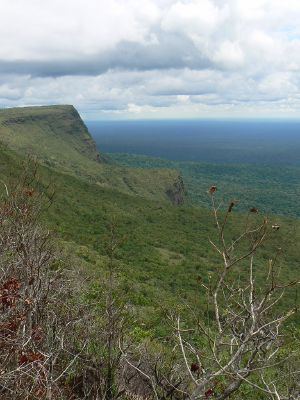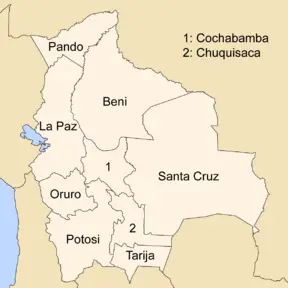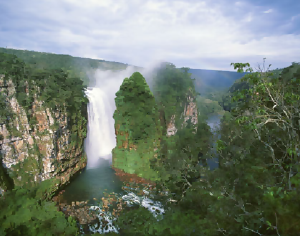Difference between revisions of "Noel Kempff Mercado National Park" - New World Encyclopedia
Vicki Phelps (talk | contribs) |
Vicki Phelps (talk | contribs) m (→Flora) |
||
| Line 73: | Line 73: | ||
It is estimated that the park has approximately 4,000 species of vascular [[plant]]s. There exist diverse types of [[bromelia]]s, [[passiflora]]s, heliconias, aráceas, and [[palm]] [[tree]]s. | It is estimated that the park has approximately 4,000 species of vascular [[plant]]s. There exist diverse types of [[bromelia]]s, [[passiflora]]s, heliconias, aráceas, and [[palm]] [[tree]]s. | ||
There are also important types of wood like the "Mara." The area includes five important ecosystems ranging from [[Amazon River|Amazonian]] [[rainforest]], gallery [[forest]], and semi-deciduous tropical forest to flooded [[savanna]] and dry cerrado. | There are also important types of wood like the "Mara." The area includes five important ecosystems ranging from [[Amazon River|Amazonian]] [[rainforest]], gallery [[forest]], and semi-deciduous tropical forest to flooded [[savanna]] and dry cerrado. | ||
| − | [[Image:Cataratas Arcoiris Bolivia.png|thumb|left|300px|The 80 m | + | [[Image:Cataratas Arcoiris Bolivia.png|thumb|left|300px|The 80 m Arco Iris waterfall in Noel Kempff Mercado National Park]] |
===Fauna=== | ===Fauna=== | ||
Revision as of 19:27, 7 January 2009
| Noel Kempff Mercado National Park* | |
|---|---|
| UNESCO World Heritage Site | |

| |
| State Party | |
| Type | Natural |
| Criteria | ix, x |
| Reference | 967 |
| Region** | Latin America and the Caribbean |
| Inscription history | |
| Inscription | 2000 (24th Session) |
| * Name as inscribed on World Heritage List. ** Region as classified by UNESCO. | |
| Noel Kempff Mercado National Park | |
|---|---|
| IUCN Category II (National Park) | |
| | |
| Location: | Santa Cruz Department, Bolivia |
| Area: | 15,234 km² |
| Established: | June 28, 1979 |
Noel Kempff Mercado National Park is a national park in the northeastern portion of the Santa Cruz Department of Bolivia, in one of the most biologically diverse areas in the world. The park was created on June 28, 1979. Its original name was Parque Nacional Huanchaca, but it was changed to honor the late Professor Noel Kempff Mercado for his research and discoveries in the park.
The general objective of the park's formation is to protect this natural area that has not been industrialized or polluted. Specific goals are to guarantee protection of the ecosystems, foster scientific research, allow visitors to enjoy its natural beauty, and help local residents improve their lifestyle.
Despite its natural beauty, lack of pollution, and isolation, the park still faces several threats, including:
- Turtle hunting
- Fishing
- Man-made forest fires
- Illegal forest exploitation
- Drug trafficking
- Inadequate financing
Geography
The Noel Kempff Mercado National Park spans 5,880 square miles (15,234 km²) in northeastern Bolivia on the border with Brazil. Bolivia is known for its diversity in climate, fauna, and flora. In the area of Santa Cruz de la Sierra the weather is very humid and warm. The normal temperature is between 25 and 29°C. The rainfall is roughly 1,500 mm annually.
The site contains an array of habitat types including evergreen rainforests, palm forests, cerrado, swamps, savannas, gallery forests, and semi-deciduous dry forests.
The cerrado (English: "closed" or "inaccessible") is a vast tropical savanna. The cerrado habitats found on the Huanchaca Plateau have been isolated for millions of years and thus contain a high diversity of plant and animal species, including viable populations of many globally threatened large vertebrates.
The cerrado landscape is crossed by gallery forests and stream valleys. Gallery forests are evergreen forests that form as corridors along rivers or wetlands and project into landscapes that are otherwise only sparsely treed such as savannas, grasslands, or deserts.
The savanna formations are not homogenous. There is great variation between the amount of woody and herbaceous vegetation, forming a gradient from completely open "cerrado" — open fields dominated by grasses — to the closed, forest-like "cerrado" and the "cerradão" ("big cerrado"), a closed canopy forest. The trees have characteristic twisted trunks covered by a thick bark, and the leaves are usually broad and rigid. Many herbaceous plants have extensive roots to store water and nutrients. The plant's thick bark and roots serve as adaptations for the periodic fires that sweep the landscape. The adaptations protect the plants from destruction and make them capable of sprouting again after the fire. As in many savannas in the world, the "cerrado" ecosystems have been coexisting with fire since ancient times; initially as natural fires caused by lightning or volcanic activity, and later caused by man.
The great habitat variability in the different types of "cerrado" supports an enormous diversity of plant and animal species.
Gallery forests are able to exist where the surrounding landscape will not support forests for a number of reasons. The riparian zones in which they grow offer greater protection from fires that would kill tree seedlings. In addition the alluvial soils of the gallery habitat are often of higher fertility and better drainage than the soils of the surrounding landscape and have a more reliable water supply at depth. As a result the boundary between gallery forest and the surrounding woodland or grassland is usually very abrupt.
The park includes a large section of the Huanchaca Plateau and surrrounding lowlands. The plateau, 150 km long and 50 km wide, covers a total area of 6,800 square kilometers. The largest river in the area is the Iténez River, which marks the border with Brazil, to the north of the park. The park is part of the drainage system of the Iténez River Basin, which includes the sub-basins of the Verde, Paucerna, and Paraguá rivers. The Verde and Paucerna rivers have their origins on the plateau and their watercourses form beautiful falls such as the Fawcett, Federico Ahlfeld, and Arco Iris. The Paraguá River dominates the lowlands to the west. This river flows into the Iténez and in the rainy season it overflows large extensions of flooded forests and savanna wetlands. To the west of the plateau, and in the lowlands, there are three great fields that become flooded at varying levels during the rainy season, and several lagoons of different size.
Flora
It is estimated that the park has approximately 4,000 species of vascular plants. There exist diverse types of bromelias, passifloras, heliconias, aráceas, and palm trees. There are also important types of wood like the "Mara." The area includes five important ecosystems ranging from Amazonian rainforest, gallery forest, and semi-deciduous tropical forest to flooded savanna and dry cerrado.
Fauna
The park is home to more than 130 species of mammals, (including rare river otters, river dolphins, tapirs, spider and howler monkeys, the giant armadillo, giant anteaters, and endangered jaguars, including a population of black jaguars). There are also 620 species of birds (including 9 species of macaw, possibly the highest number of species in any one protected area), 74 species of reptiles, including black caiman and snakes, and 62 species of amphibians and fish.
The high population of birds accounts for 20 percent of the all bird species in South America). Recent studies say that these numbers would increase if migratory birds were included.
The park has 347 species of insects, including some of the rarest in the world, many of which have not yet been studied. Butterflies in a range of colors can be found.
Looking to the future
Through a unique partnership, the government of Bolivia, the Friends of Nature Foundation, The Nature Conservancy, and three energy companies (American Electric Power, PacifiCorp, and BP Amoco) have teamed up to jointly implement the $11 million Noel Kempff Mercado Climate Action Project—the largest forest-based carbon project in the world.
At the Noel Kempff Mercado National Park, a unique partnership was forged between the Government of Bolivia, Friends of Nature Foundation (FAN) (a non-profit conservation organization headquartered in Santa Cruz, Bolivia), The Nature Conservancy (the world’s largest conservation organization headquartered in Arlington, VA), American Electric Power, (an electric utility company headquartered in Columbus, OH), BP Amoco (a major petroleum company headquartered in London) and PacifiCorp (an electric utility company headquartered in Portland, OR) in 1997 to protect nearly four million acres of threatened tropical forests in the Department of Santa Cruz, Bolivia for at least 30 years. The primary purpose of the project is to sequester (capture) carbon dioxide and store carbon that would have been released as a result of logging activities in the area. At the same time, the project preserves one of the richest and most biologically diverse ecosystems in the world and fosters sustainable development in local communities. It is the largest project of its kind in the world and serves as a showcase for an innovative and cost-effective approach to abating greenhouse gas emissions. These emissions are increasing rapidly and accumulating in the atmosphere and may trigger adverse global climatic changes.
The NKMCAP is projected to avoid emissions of 7-10 millions tons of carbon or 25-36 million tons of carbon dioxide during its 30-year life. The project has been approved by the governments of the United States and Bolivia. Prior to the project, the Park was under imminent and demonstrable threat from logging and conversion to agriculture. The project consists of numerous components: park expansion and protection activities; ecotourism; sustainable development for local communities; a for-profit venture to generate revenues for the Park (Canopy Botanicals); monitoring & verification activities; and support to the Government of Bolivia’s climate change program.
Accurately measuring and reporting the level of carbon dioxide captured as a result of the project is one of its most important components. Using Measuring the tree thorough field procedures at 625 permanently established carbon plots in the Park, and about 100 permanent plots in nearby active forest concessions to measure real logging impacts and an advanced dual camera aerial videography technology developed at the University of Massachusetts, the monitoring and verification program will quantify with a high degree of precision how much carbon existed in the project area prior to commencement of the project, the carbon losses avoided, and how much carbon is captured as a result of the project. The monitoring and verification program was developed with assistance from one of the world’s foremost experts in the field, Winrock International, headquartered in Arkansas. Recording statistics The project team uses a rigorously peer-reviewed methodology that employs commonly accepted forest inventory practices, soil science and ecological survey principles. Project participants can take credit only for carbon offsets that result from the avoidance, reduction or mitigation of emissions that are additional to those that would have happened without the project. There is little doubt that without the project, logging concessionaires would have continued harvesting timber on the property and, subsequently, much of the land would have been cleared.
A Technical Advisory Panel has been established to internally verify the validity, precision and thoroughness of the carbon monitoring procedures employed to measure and report carbon offsets to the Government of Bolivia for certification. An independent external verification process will be developed in the future to enhance the integrity of the process and ensure its accuracy.
Weighing the trees The measurements are used to determine the level of carbon offset credits to allocate to project participants. The project developed a unique and equitable offset sharing system that provides 49% of the offset credits to the Government of Bolivia, 49% to the industry contributors and 2% to American Electric Power, the lead investor, as a project development "bonus." The Government of Bolivia is required by contract to spend the proceeds from the sale of offset credits on Park management activities in Noel Kempff and throughout Bolivia, and on other biodiversity preservation activities.
External links
- Official UNESCO website entry
- Climate Action Project
- World Conservation Monitoring Centre
- Travel site with photos
- Photos
- Photos
- Short amateur video of waterfall Arco Iris in Noel Kempff Mercado National Park
- Short amateur video of waterfall Ahlfeld in Noel Kempff Mercado National Park
| |||||||
Credits
New World Encyclopedia writers and editors rewrote and completed the Wikipedia article in accordance with New World Encyclopedia standards. This article abides by terms of the Creative Commons CC-by-sa 3.0 License (CC-by-sa), which may be used and disseminated with proper attribution. Credit is due under the terms of this license that can reference both the New World Encyclopedia contributors and the selfless volunteer contributors of the Wikimedia Foundation. To cite this article click here for a list of acceptable citing formats.The history of earlier contributions by wikipedians is accessible to researchers here:
The history of this article since it was imported to New World Encyclopedia:
Note: Some restrictions may apply to use of individual images which are separately licensed.



